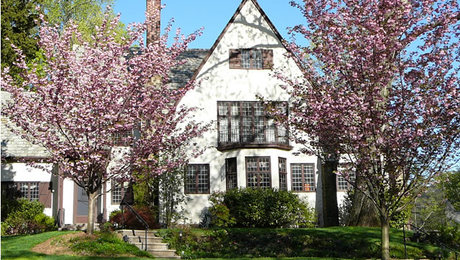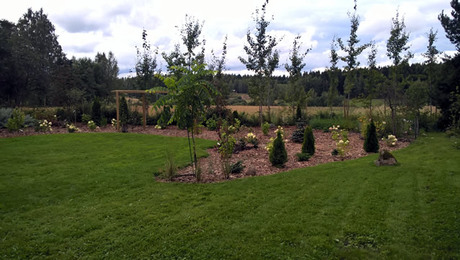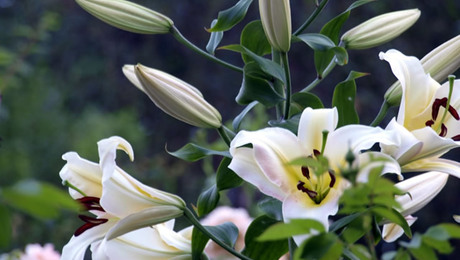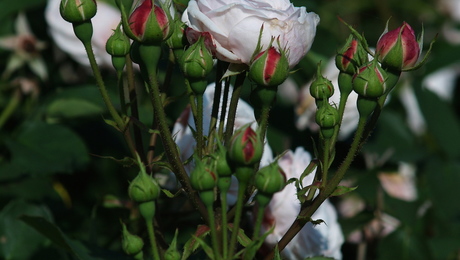
Photo/Illustration: Paul Zimmerman Roses

Photo/Illustration: Paul Zimmerman Roses
I thought we’d take a little break from the planting and learn something fun about roses this week. Some thing that, while not essential, is fun to know. And that is how to time the bloom cycle on your roses.
What is the bloom cycle? This is the time it takes the rose bush to produce another flower. The beginning of the cycle is the moment you deadhead off the old bloom and the end is when a new bloom opens up.
Why would we want to do this?
Say you have a party coming up in August and you want your roses in full bloom for the event. Or maybe a backyard wedding. Maybe you need a lot of cut flowers for a special event. Or your in-laws are coming to visit and you want to score some points. Regardless of your reasons it’s a fun thing to know how to do.
Timing the bloom cycle involves cutting off all blooms and buds so the bloom cycle for the entire bush begins and ends at the same time. Exhibitors do this to get ready for a big show. We’ll start with how to do it and then you can use the chart below to determine what the bloom cycle is for your particular plant.
How to begin
You do this via normal deadheading techniques. You count down to the second or third leaflet group and make your cut at an angle just above it. With shrub roses I don’t worry much about inward or outward facing eyes. I just make sure I’m cutting above healthy vigorous growth. Now, during normal deadheading we only have to worry about cutting off the blooms that are faded or no longer have petals. This encourages the bush to constantly replenish itself and gives you a pretty constant bloom over the growing year.
But for this we are trying to time the bush to cover itself in blooms all at once. Not only one bush but your whole garden. Beautiful? Yes. But it calls for radical surgery to pull it off. All the blooms, new and old, and all the buds have to be cut off. No exceptions. A true expert can play with this rule but this kind of touch is beyond most of us.
So cut off everything. New buds, new blooms and old blooms.
A couple of things to remember.
The chart is timed using cuts at the level of the second or third leaflet group below the bloom or bud. The further down you go the longer it takes for the blooms to come back. The general rule of thumb is to add about five more days for each additional leaflet group you go down.
Using the chart below is easy. Look up the type of plant you have and the number of days in the bloom cycle. Find the date of your event on the calendar, count back the numbers of days in the bloom cycle and that’s when you should make all your cuts. This chart was written for late spring/summer time temps here in the foothills of the Carolinas. If you are in a cooler climate add a few days and in a really warm climate subtract a few.
If you aren’t sure then cut 1/3 of your bushes one day, 1/3 a few days later and the rest a few days after that. At least something will have flowers!
That should do it. Just remember the simple rules. Take it all off and make your cuts above the second or third leaflet group. Those are the basics. Now get out there and impress your guests!
Type of Rose Number of Days in Bloom Cycle
Bourbons 55-60
English They are all different but figure 50-60
Floribundas 50-55
Hybrid Musks 55-60
Hybrid Perpetuals 60-65
Hybrid Rugosas 55-60
Hybrid Tea 45-55
Miniatures 35-40
Portlands 60-65
Teas 45-50
Fine Gardening Recommended Products

A.M. Leonard Deluxe Soil Knife & Leather Sheath Combo
Fine Gardening receives a commission for items purchased through links on this site, including Amazon Associates and other affiliate advertising programs.


















Comments
Thanks for this information.
Wish I had known this years ago!
when you say second or third leaflet group are you counting the first leaflet group below the bud as the first or second?
Hi!
I have 2 miniature rose plants which have 3 leaflet all over.it blooms post office red roses.the bushes are very tiny for a rose plant.there is no fragrance also.can anyone please tell me,what rose plant it is?
Log in or create an account to post a comment.
Sign up Log in